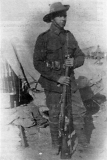Ohinemuri Regional History Journal 41, September 1997
Sgt. John Hoey Moore. D.C.M. Reg. No. 101. 14th Field Coy. Engineers. A.I.F. 1914-19.
By J H Moore
My father Jack Moore was born in Paeroa 1888 and brought up on the goldfields of Ohinemuri. His mother's brother was Billy Nicholl, the mining pioneer who named and first developed the Martha mine in Waihi in 1880. Jack's father, John Hoey Moore senior was a well-known mine manager in the goldfields area and at one stage was manager of the Martha. From 1885 to 1889 he was an Ohinemuri County councillor and chairman from 1889 to 1890. As evidence of Jack Moore junior's schooling in Paeroa, his name appears on the District High School Roll of Honour for World War One.
He served his time at the Waihi Gold Mine's ore crushing battery in Waikino and qualified as a mechanical engineer. He went to Australia in 1912 and was working in Sydney when the Great War started in August 1914. He volunteered for the Australian Army and two weeks later was assigned to the 14th Field Coy Engineers. His service number of 101 attests his early entry. He left for Europe two months later, on the troopship Africa. The Australian ships, and those from New Zealand which joined the convoy in Western Australia, were diverted to Egypt. On 25 April 1915 at dawn he landed with the Australian troops on Gallipoli. A month later he was wounded with a rifle bullet through his shoulder and evacuated to a hospital in Malta. From there he was shipped to England to recuperate. When fit again, he was sent back to Egypt.
Early in 1916 he returned to England where the Headquarters of the Australian Engineers had been established. He was promoted to the rank of corporal and given the job of training raw Australian recruits. Unhappy with this he volunteered to forgo his promotion if he could be sent to fight on the Western Front in France against the Germans. This was approved and after spending nearly two years on active service he was sent back to Australia on furlough for two months. He returned to the Western Front on active service until the Armistice in November 1918. After this he was with the army of occupation in Belgium. He returned to England in mid 1919 and was sent back to Sydney where he was discharged after exactly five years of service, most of it active.
He was promoted to the rank of sergeant while serving in France and in November 1917 was awarded the D.C.M. for, "Conspicuous Gallantry and Devotion to Duty". He was leading forward his section and an infantry working party when they suffered heavy casualties. In spite of the heavy fire he gallantly led his men forward and carried out the work which he had been ordered to do. He set a splendid example of courage and determination."
(Published in the London Gazette. 7th November 1917.)
Jack Moore was from the same mould as most of the boys from "Down Under", whether from Australia or New Zealand it didn't matter. The common bond they forged on the slopes of Gallipoli and on other battlefields has lived on for eighty odd years as a result of the mutual respect they generated. They were an unknown quantity in 1915, fit only for garrison duties according to the Germans, who were soon forced to change this opinion and acknowledge the fighting prowess of the Anzacs.
Jack Moore was a unique Anzac, being New Zealand born and fighting under the Australian flag. He returned to New Zealand after the War and in 1924 married Elsie Fielding of Waitekauri. Her mother was a daughter of the original Gordon family of Waitekauri and thus three prominent families in the goldfields were united, the Moores, the Nicholls and the Gordons. He died suddenly in 1929 and one of his legacies to me was a trunk packed with letters he had written to the family during his five years of active service. These have proved to be an invaluable record of his experiences. They convey the fascination of seeing new countries, the comradeship, the temporary madness in battle, the pain and most of all the futility of war with its effect on both victor and vanquished alike. Thoughts and expressed concern for loved ones left worrying at home are always to the fore in these letters while at the same time he glosses over the risks a soldier faces in order to lighten their apprehension. The humour, the tragedy, the blunt criticism and the disregard of discipline off the battle fields by the Colonial troops is typical of the experiences of many New Zealand servicemen during both World Wars.
Jack Moore was a true son of Paeroa and the Ohinemuri while at the same time proud of his association with Australia. He followed the example of the "Gallant Six" from Paeroa during the Boer War and left his own mark in history some fourteen years later.

